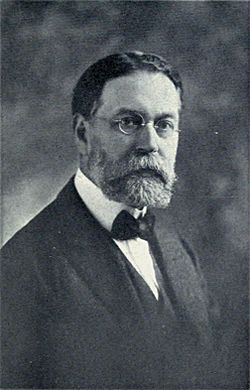Edwin R. A. Seligman facts for kids
Quick facts for kids
Edwin R. A. Seligman
|
|
|---|---|
 |
|
| Born | April 25, 1861 |
| Died | July 18, 1939 (aged 78) |
| Nationality | American |
| Institution | Columbia University |
| Alma mater | Columbia University |
| Doctoral advisor |
John Burgess |
| Doctoral students |
B. R. Ambedkar Paul Douglas Robert Murray Haig Alvin Saunders Johnson |
Edwin Robert Anderson Seligman (1861–1939) was an American economist. He spent his entire career teaching at Columbia University in New York City. Seligman is best known for his important work on taxes and how governments manage their money (called public finance).
His ideas for a fair, progressive income tax were used by the U.S. Congress. This happened after the Sixteenth Amendment was passed. He was a great scholar and teacher. Many of his students helped shape the financial systems of new countries. He also helped start the American Economics Association.
Contents
Early Life and Education
Edwin Seligman was born on April 25, 1861, in New York City. His father, Joseph Seligman, was a banker. As a child, Edwin was tutored by Horatio Alger, a famous writer. Edwin was very good at learning different languages.
He started attending Columbia University when he was just fourteen years old. He graduated in 1879 with a bachelor's degree. Seligman continued his studies in Europe for three years. He took classes at universities in Berlin, Heidelberg, Geneva, and Paris. He earned several advanced degrees, including a master's degree and a Ph.D., by 1885. He later received another special law degree in 1904.
A Career at Columbia University
Seligman spent his whole working life at Columbia University. He started there as a lecturer in 1885. By 1888, he became a professor of political economy. In 1904, he became the first McVickar Professor of Political Economy. He held this important position until 1931.
Focus on Taxes and Public Money
Seligman's main work was about taxes and how governments handle money. He was a strong supporter of the progressive income tax. This means people who earn more money pay a higher percentage in taxes. He also taught classes on economic history at Columbia.
From 1886, Seligman was an editor for the Political Science Quarterly magazine. He also edited Columbia's series on history, economics, and public law starting in 1890.
Leading Economic Organizations
Seligman helped create the American Economic Association. He served as its president from 1902 to 1904. He was also a key person in forming the American Association of University Professors. He was the president of this group from 1919 to 1920.
Influence on War Finance
During World War I, Seligman worked hard on how to pay for the war. He strongly believed that a progressive income tax was the best way for the government to get money.
Seligman believed in the "economic interpretation of history." This idea suggests that economic factors play a big role in how history unfolds. However, he was against socialism. He even debated famous radical thinkers in the early 1920s.
Later in his career, Seligman focused on tax rules and how people pay for things over time (consumer finance).
One of his most famous students was B.R. Ambedkar. Ambedkar later became the main writer of the Constitution of India. Seligman stopped teaching in 1931.
Later Life and Impact
Edwin Seligman passed away on July 18, 1939. His ideas had a big impact on other scholars. For example, Charles A. Beard, a colleague at Columbia, was influenced by Seligman's economic views on history. This helped Beard write his famous book, An Economic Interpretation of the Constitution of the United States.
Seligman also mentored other financial experts, like Carl Shoup. Seligman's ideas helped guide tax reforms after World War II.
Selected Works
Books
- The General Property Tax. 1890.
- The Next Step in Tax Reform. 1915.
- A University School of Business. 1916.
- Financial Mobilization for War. (Editor) 1917.
- Studies in Public Finance. 1925.
- Essays in Economics. 1925.
- The Economics of Instalment Selling. 1927.
- The Economics of Farm Relief. 1929.
- Price Cutting and Price Maintenance. With Robert Alonzo Love. 1932.
- A Report on the Revenue System of Cuba. With Carl S. Shoup. 1932.
Articles
- "Economists," in Cambridge History of English and American Literature, 1907.
- "The Crisis of 1907 in the Light of History," in Edwin R.A. Seligman (ed.), The Currency Problem and the Present Financial Situation: A Series of Addresses Delivered at Columbia University 1907-1908. 1908.
- "Recent Reports on State and Local Taxation," American Economic Review, 1911.
- "The Crisis in Social Evolution," in Albert Bushnell Hart, et al., Problems of Readjustment After the War. 1915.
- "Tax Exemption Through Tax Capitalization: A Reply," American Economic Review, 1916.
- "Loans versus Taxes in War Finance," in Financing the War. 1918.
- "Who is the Twentieth Century Mandeville?" American Economic Review, 1918.
- "Are Stock Dividends Income?" American Economic Review, 1919.
- "The Cost of the War and How It Was Met," American Economic Review, vol. 9, no. 4 (Dec. 1919), pp. 739–770.

